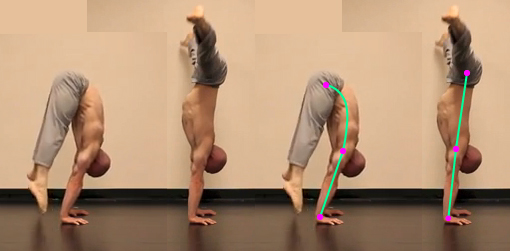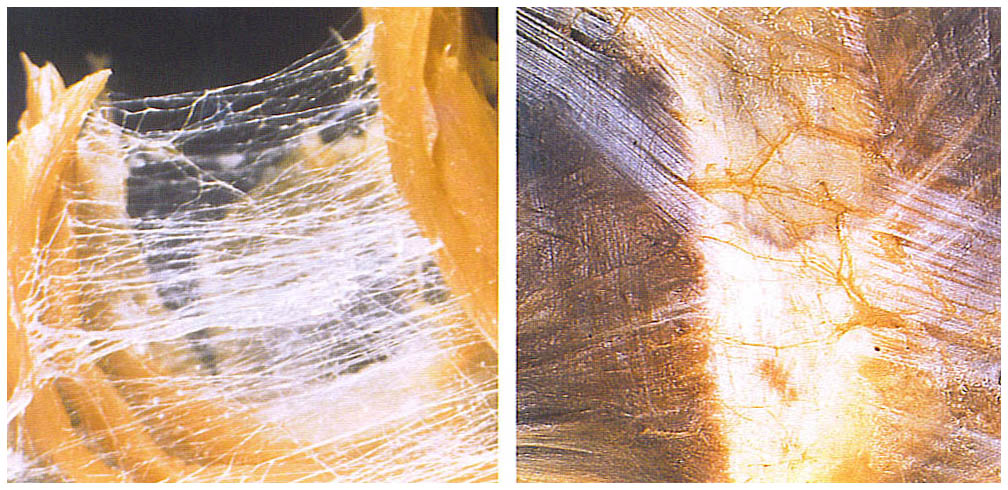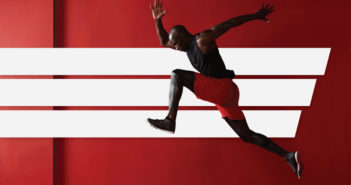by Luke Sherrell from AMN Academy

What do you think is more important, Strength and Power, or Coordination and Flexibility?
It depends on the goal I hear you cry! Plus, how strong or how flexible are we talking here? There is a big difference between achieving box splits when compared with touching your toes or bench pressing 200kg’s vs nailing a pull up.
These are fair comments so let me put this another way. If you could be naturally gifted with strength and power or coordination and flexibility, which would you choose?
In the absence of specific goals, the way I’d answer this question is to consider which of the movement qualities are the most difficult to acquire? Without wishing to upset vast numbers of strength and conditioning enthusiasts and coaches, having worked with hundreds of clients for many years, I am inclined to say that it is a simpler process to gain strength and power than it is to become more coordinated and flexible!
Note that I said simpler and NOT easier.
The pursuit of high levels of strength is hard work but if you utilise a progressive training system that involves the manipulation of intensity (load) and volume, over time, you will get stronger. If you also practice moving quickly while applying force, you will become more powerful. I would also like to point out that depending on the individual, the constant pursuit of these two qualities exclusively is often to the detriment of overall movement quality.
Flexibility, mobility and coordination are a little more complicated to acquire. Gaining large increases in flexibility for example is such a long and slow road that many trainers simply don’t include it in their programming. If a client came to you and said I want to become more coordinated, it would be understandable if you felt a little out of your depth. You would first need to understand why the individual is poorly coordinated, which systems to stimulate and which sort of movements are appropriate.
In the world of body weight training, people who are coordinated and flexible require less strength. They have the capacity to manipulate their bodies into angles of leverage that are advantageous instead of fighting against their own tensions and having to muscle their way through things.

Effortless coordination also suggests that someone also has a highly developed motor system. The peripheral nervous system, cerebellum, pre-motor and motor cortices are well educated, they have a large movement vocabulary, or as I like to call it they have a high level of Movement Intelligence.
So are the elusive skills we speak of more important than strength and power? That really is open to debate, a debate that I do not wish to get in to at this stage. Maybe it’s not that coordination and flexibility are vastly harder to achieve, rather most trainers are less comfortable with how to coach these qualities.
In the AMN system, skill work is the expression of all four qualities and I would like to make a case as to why we should start looking at skill movements as viable exercise options for clients.
Stuntman Olympics
If there was such a thing, I would be there to watch every single year because of all the athletes I’ve worked with, stuntmen are simply the most awesome.
To be a successful stuntman in modern movies you need to be able to perform:
Acrobatics
Martial Arts, Gymnastics, Parkour, Tricking, Diving, Deep sea diving and Swimming and at some point become comfortable with explosions and being set on fire. These guys are the most impressive athletes I’ve ever seen and their movement skills completely eclipse those of traditional sports.
Our skill based movement system is designed to give the novice trainee, that’s the vast majority of personal training clients and with all due respect, most trainers, somewhere to start learning skill based movement. But its not just friend impressing awesomeness that is up for grabs here.
Skill work combines the expression of strength, power, coordination, mobility, flexibility and balance. There are untold benefits to this kind of movement neurologically but in an industry obsessed with mechanics, many will be pleased to hear that its pretty good for the fascial system too.
Fascia is not simply a mechanical system, far from it! In fact there is no part of the human that is simply mechanical.
Fascia
Fascia has had a pretty big push in the manual therapy and Health & Fitness literature over the last 10 years or so, putting it right at the top of the most popular and often talked about tissue in the human body, and quite rightly so, it’s very important and influential stuff.
Fascia is the primary connective tissue of the body and has many recognisable guises such as ligaments, retinacula, tendons, aponeuroses, fascial bands, plura, meninges, perimysium, epimysium and even the pericardial sac. It is the very fabric that makes the body one single unfathomable piece of genius engineering!
There are a several fascial researchers and therapists whom I greatly respect. Luigi Stecco of Fascial Manipulation is one of them;
Fascia, what is it?
“In medicine, it has always been considered to have a mere function, or role, of containment or restraint, a type of packing material. In recent times, this view has changed somewhat. Fascia actually extends within the muscle, via the perimysium and the endomysium. This continuity means that the contraction of each single muscle fibre transmits to the deep fascia, or the outer most layer of muscle compartments. It is now thought that the fascia could be considered as a conductor of an orchestra playing a symphony of movement, where it synchronises the crescendo of some muscles and the diminuendo of others. The result is harmonious motion.”
Interview of Luigi Stecco by Massimo Ilari
Since some very smart surgeons and anatomists realised that fascia may be more than just the white stuff you need to cut away to get to the muscles, research and hypotheses have come out thick and fast. While some of the claims of fascial based manual therapy techniques may still be unsubstantiated, one description of the fascial system seems to hold true.
Slipping and Sliding
“Musculoskeletal dysfunction is considered to occur when muscular fascia no longer slides, stretches, and adapts correctly and fibrosis localises in the intersecting points of tension, known as cc and cf. Subsequent adaptive fibroses can develop as a consequence of unremitting non-physiological tension in a fascial segment”.
A Pilot Study: Application of Fascial Manipulation(c) technique in chronic shoulder pain – Anatomical basis and clinical implications. By Day JA, Stecco C, Stecco A (JBMT, 2009)
Whilst I would add a few different and influential factors to explain musculoskeletal dysfunction, I accept the fact that the fascial system works optimally when it is mobile.
Form follows function?
Is a principle associated with modernist architecture and industrial design in the 20th century. The principle is that the shape of a building or object should be primarily based upon its intended function or purpose
We’ve all heard this phrase used within the health and fitness industry to promote a term I hate; ‘functional training’. Well, I don’t really like this statement about form and function either. In an evolutionary sense and with regards to movement, the function of the body was to be capable of interacting effectively with the environment.
Walk, Run, Jump, Hunt, (fight), Climb and Swim : Adaptable Locomotion
A hypothesis as to why we have such incredibly powerful brains is due to our capacity for complex motion, the variance of the environment and a necessity to be able to predict outcomes of such interactions so as to promote our survival.
These days, the function of the human body is having the freedom and potential to do whatever we want with it. Our form, our design if you will, affords us near limitless movement potential.
Move in a manner that promotes and integrates our form and improved function will follow
Move in a manner that over simplifies our form and function can degrade
Collagen
In response to regular physiological strain, collagen, the basic compound of our connective tissues adapts by altering its architectural properties to meet the imposed demand.
In healthy subjects 50% of collagen fibrils are replaced annually as part of the natural cycle of cellular life. There are hypotheses to suggest that certain movement practices can influence this cycle so as the renewal process promotes improved extensibility, hydration and sliding of fascia which is displayed via increased mobility through open joint angles.
As ever I shall point out that fascia is not alone in this process. In fact it is the proprioceptive sensory system that does the learning, the tissues do the adapting.
If you’ve ever been amazed, annoyed or both at how incredibly mobile kids are, don’t worry. The example thrown around comparing adult mobility to that of a toddler is plain stupid and in fact, it annoys me! The connective tissue matrix of a child is structurally different to that of an adult. The collagen structure of a child is more undulating, making it naturally much springier. The elderly show fascia that is much flatter and less responsive and there’s even variability in these qualities from person to person.
‘My 3 year old may have a pretty sweet looking straddle with no training but ask him to jog on the spot as silently as possible and he’ll bash around like a baby rhino.. He may have springy fascia but it’s not all its cracked up to be without motor control!’
Whether it’s been proven in a lab or not, (and apparently it has been) anecdotally we see it all the time. Tissue extensibility improves with the right kind of movement practices. It’s no coincidence that the connective tissue AND nervous systems of Capoeiristas, Gymnasts and Dancers allow them to move with grace and fluidity through full ranges of motion and those of your average weights trainee does quite the opposite.
How we choose to move is important.
Counter movement and elastic recoil
As if learning to be awesome wasn’t enough! The pursuit of athletic drills and movement skill practice is right on the money to enhance the energy store and release capacity of fascia.
The elastic storage capacity of fascial tissue can be enhanced with correct practice. When performing an athletic warm up we kick shoes off and coach clients to stay on the balls of the feet. We advise that ground contact time should be minimal and they should aim to be as quiet as possible.
Becoming fast and reactive through the lower limbs is a product of training. It strengthens the feet and goes a long way to improving athletic movement in ball sports such as tennis and squash. Some have it naturally while others have to earn it, but it can always be learned and improved.
The energy returning, recoil extensibility of the connective tissue matrix is subconsciously utilised any time we ever jump, throw or kick a ball, it’s also present in just about every one of the dynamic skill movements we provide in the fundamentals.
Flexibility
Flexibility is not gained with a single approach. It is the net result of several complimentary practices of which movement skills like cartwheels, handstands, rolling, athletic drills, bridges and scoots are part of.
With this in mind, let me conclude this article with another question.
“What is more useful and rewarding for you and your clients?”
1. Learning to move in complex patterns that build strength, mobility, coordination, are in tune with our form, improve the brain by engaging in the process of learning and make you look awesome at house parties?
Or
2. Generic dumbbell rows and chest presses?
I’m a bit biased so I’ll leave you to decide on that one.






1 Comment
Pingback: Fascia | Pearltrees